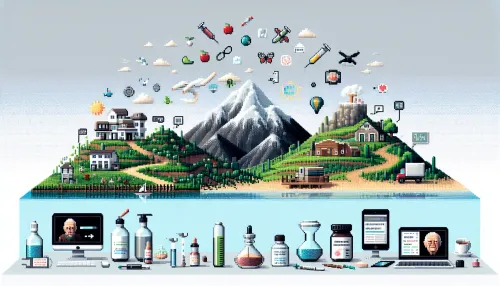Revolutionizing Recovery: The Next Generation of Post-Injury Rehabilitation

Introduction to Next-Generation Rehabilitation Technologies
Injury recovery has embarked on an unprecedented journey, embracing technology in ways that promise a new era of health and wellness. The Peppino Blog delves into how the cutting-edge innovations are revolutionizing the field, providing readers with insights into modern methods that are redefining rehabilitation.
Harnessing AI for Personalized Rehabilitation Programs
Artificial intelligence is rapidly becoming a cornerstone in personalized rehabilitation programs. Machine learning algorithms are capable of analyzing vast amounts of data on patient recovery, enabling the creation of customized rehab routines that evolve in real-time to suit each individual's progress and response. By analyzing movement patterns and predicting potential setbacks, AI is facilitating faster, more effective recovery processes that are tailored to each patient's unique needs.
The ability to adjust rehabilitation plans based on dynamic analysis means fewer generic exercises and more focus on problematic areas, which can significantly reduce overall recovery time. As machine learning continues to advance, patients utilizing these personalized regimens can look forward to even greater improvements in their rehabilitation outcomes.
Bioprinting has made a name for itself for its role in tissue regeneration, standing out as one of the most remarkable breakthroughs in modern medicine. This process involves using 3D printing technology to create complex tissues such as skin, bone, and cartilage for use in patient rehabilitation. Peppino Blog readers interested in technological advancements will find this development particularly intriguing.
Related Article: The Science of Sleep: Optimizing Your Rest for Health and Vitality
Bioprinting Breakthroughs in Tissue Regeneration
By using a patient's own cells, bioprinting has the potential to minimize rejection risks and enhance recovery times. Not only does this technique hold promise for post-injury application but also for creating patches for damaged heart tissue or treating burns by printing skin. As this technology matures, it could redefine regenerative medicine and offer new hope for patients facing extensive recoveries.
The use of virtual reality (VR) gaming elements has emerged as an engaging method to encourage patients during physical therapy sessions. VR-based rehab protocols are making the healing process more enjoyable and interactive by immersing patients in virtual environments where they can perform exercises designed as games.
Gamifying Healing: The Role of Virtual Reality in Therapy
Not only does gamification make therapy more fun, but it also allows physical therapists to track progress accurately and motivate patients through instant feedback and rewards systems. Integrating VR into rehabilitation offers immense potential to inspire greater patient adherence to therapy regimes a critical factor in successful recovery.
Moving beyond opioids and traditional pharmaceuticals, the healthcare industry is witnessing a surge in non-pharmaceutical pain management techniques. These innovative approaches aim to reduce dependency on medications while effectively managing discomfort during the recovery process.
From transcutaneous electrical nerve stimulation (TENS) devices to cryotherapy and acupuncture, a myriad of alternatives now stands forefront in modern pain management practices. Each method provides unique benefits without the risks associated with opioid use, making them attractive options for those seeking holistic recovery methods.
Exploring Non-Pharmaceutical Pain Management Innovations
Wearable technology is transforming how we monitor post-injury recovery progress. Smart devices equipped with sensors provide real-time data on patient movement quality and frequency, offering vital insights into their current state during rehabilitation.
Smartwatches and fitness trackers can gauge how active a patient is throughout their day while ensuring that activities are within prescribed limits, preventing overexertion. As wearable tech becomes more advanced, it not only empowers patients with immediate feedback but also enables healthcare providers to fine-tune rehab programs according to precise data collected from these devices.
Wearable Technology: Monitoring Recovery Progress
Robotics is making strides within rehabilitation services by introducing autonomous systems designed to assist patients. Exoskeletons help individuals regain mobility by supporting weak limbs during exercise routines, allowing them to perform movements that would otherwise be impossible.
Robotic arms facilitate fine motor skill recovery by guiding patients through complex tasks with precision. The continuous interaction between patients and these intelligent machines accelerates progress while ensuring exercises are done safely and effectively.
The Impact of Robotics on Rehabilitation Services
Neural interface technology represents the next frontier in rehabilitation by offering the ability to restore movement and sensation in limbs affected by severe injuries or conditions like strokes. By bridging gaps between the nervous system and muscles or prosthetics, these interfaces can translate thought patterns into actions enabling control over previously unresponsive limbs.
As research progresses, neural interfaces may significantly alter the landscape of physical therapy by empowering patients with direct control over their own healing journey through their thoughts an inspiring glimpse into tomorrow's therapeutic tools.
Tele-rehabilitation has emerged as a versatile solution providing expert care to those in remote locations. This approach uses telecommunication technology like video conferencing to deliver therapy sessions virtually. With access issues removed, patients no longer face geographic barriers when seeking high-quality rehabilitation services.
Neural Interfaces: Restoring Movement and Sensation
This form of rehabilitative care is especially beneficial now that digital connectivity has become more ubiquitous and accessible than ever before ensuring continuity of therapy regardless of location while maintaining direct contact with healthcare professionals.
Finally, prolotherapy offers an innovative approach through regenerative injections that stimulate healing processes within the body itself. This method strategically injects natural substances into injured areas to incite reparative responses from local tissues accelerating the overall healing timeline.
Tele-Rehabilitation: Expert Care from Afar
Prolotherapy stands out amongst various techniques by promoting long-term wellness rather than offering just temporary relief from symptoms or pain encapsulating Peppino Blog's commitment to exploring comprehensive health solutions that stand the test of time.
Frequently Asked Questions
Artificial intelligence is crucial in creating personalized rehabilitation programs. By analyzing patient data, AI can tailor rehab routines that adapt in real-time to individual progress, enhancing recovery speed and effectiveness. This technology focuses on specific problem areas, reducing generic exercises and improving overall rehabilitation outcomes for patients.
Bioprinting utilizes 3D printing technology to create complex tissues such as skin and cartilage for rehabilitation. By using a patient's own cells, this method minimizes rejection risks and accelerates recovery times. It holds promise for various applications, including treating burns and repairing damaged heart tissue, potentially transforming regenerative medicine.
Wearable technologies provide real-time monitoring of patient progress during rehabilitation. Devices like smartwatches track movement quality and activity levels, offering valuable insights into recovery. This data helps healthcare providers adjust rehab programs based on precise information, ensuring patients stay within safe activity limits while empowering them with immediate feedback.
Check Out These Related Articles

Gut Instincts: Leveraging the Gut Microbiome for Optimal Health

The Impact of Gut Health on Mental Well-Being: New Insights from Microbiome Research

Breaking Through the Noise: Combatting Misinformation in Nutrition and Wellness
